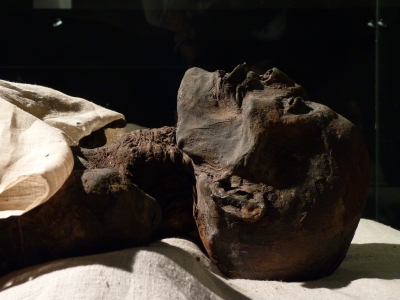
The embalmers first had to remove the moist parts of body which would rot. The brain was removed through the nostrils with a hook and thrown away because it was not believed to be important. The internal organs were removed through a cut in the left side of the body. The lungs, liver, stomach and intestines were mummified separately and placed in special containers called canopic jars.
The heart was left in the mummy in order to be weighed against the ‘Feather of Truth and Justice’ in the afterlife by the God Anubis. If the deceased had done bad things then their heart would be heavy and they would not be allowed into the afterlife. Instead Ammit (who was part crocodile, lion and hippopotamus) would devour them. Only if the heart weighed the same as the feather could the deceased person go into the afterlife. The body was covered in a kind of salt called natron for 40 days to dissolve body fats and absorb the moisture.
Linen was used to pad out the cavities and the body was treated with herbs, oils and resin. Make-up, jewellery and a wig were usually placed on the body. Any missing or damaged parts would be replaced with wooden parts so that the person’s body would be complete in the afterlife.
Protective amulets (necklaces) were placed on the body like the scarab amulet and the wedjat eye amulet. The embalmers then wrapped the body in linen bandages; this took 15 days while spells and rituals were performed to ensure safe passage to the afterlife. The body was fitted with a mask and placed in a coffin or series of coffins.
The ‘Opening of the Mouth’ ceremony took place just before burial. The priest would touch the face of the coffin with special instruments to restore speech, sight and hearing for the afterlife. The coffin was then placed in the tomb and surrounded by possessions and small model workers called shabtis, who would work for the dead in the afterlife.
Credit : My Learning
Picture Credit : Google




